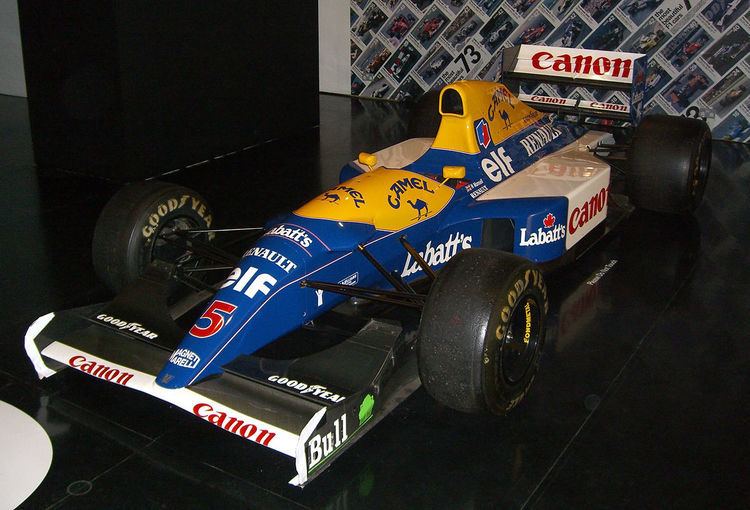Category Formula One Predecessor FW13B | Constructor Williams Successor FW15C | |
 | ||
Designer(s) Patrick Head (Technical Director)
Adrian Newey (Chief Designer) Chassis Carbon fibre and honeycomb composite structure | ||
The Williams FW14 was a Formula One car designed by Adrian Newey, used by the Williams team during the 1991 and 1992 Formula One seasons.
Contents
The car was born out of necessity, as the 1989 and 1990 seasons had proven competitive for Williams, but they had underachieved in their own and Renault's eyes. Newey started work on the new car soon after joining the team from March in mid-1990. He had designed a series of aerodynamically efficient and very effective cars for March on a limited budget, so with Williams's greater resources and money he was able to fully develop his ideas. The design showed enough promise to tempt Nigel Mansell to shelve his plans to retire from the sport and rejoin Williams from Ferrari.
Powered by a 3.5 litre V10 Renault engine, the car was the most technically sophisticated on the grid. By 1992 the FW14B featured semi-automatic transmission, active suspension, traction control and for a brief period anti-lock brakes. Add to that the superb aerodynamics by Newey that was far ahead of the McLaren MP4/7A, Ferrari F92A or Lotus 107, and it made for a potent mix, although at the beginning the unbelievers said the car was too technical for its own good. The FW14B was so successful that its successor (the FW15), which was already available mid-season in 1992, was never used.
The FW14 made its debut at the 1991 United States Grand Prix. The car was clearly the most technically advanced on the grid, but teething troubles during the season stymied the team's early progress. Nigel Mansell and Riccardo Patrese recorded 7 victories between them, but the Drivers' Championship was wrapped up by Ayrton Senna in the McLaren MP4/6, who had better reliability.
Williams had the faster car throughout the balance of the season and it provided a run of good form in the mid season for both Mansell and Patrese. Mansell in particular however had several retirements due to the then new-for-Williams semi-automatic transmission, with most of these retirements occurring while in a position to win races. Patrese was impressive on several occasions, and retired while leading twice. McLaren's superior reliability told in the Constructors' Championship as well, as they narrowly took the title from Williams.
Williams FW14B
In 1992, after further development work was done to the gearbox, traction control and active suspension system, the FW14B was the dominant car and Mansell wrapped up the 1992 Drivers' Championship with a then record 9 wins in a season, whilst Patrese scored a further win at the Japanese Grand Prix. Patrese did not warm to the car as much as the FW14, as he preferred the passive suspension in that chassis, whereas the increased level of downforce generated by the FW14B suited Mansell's aggressive driving style much better. The main visible difference between the FW14 and FW14B were a pair of bulbous protusions above the latter's front pushrods, which contained the active suspension technology. The FW14B also featured a longer nose section.
The result was that there were many races in the 1992 season where Mansell and Patrese would gain 2 seconds on the rest of the field, especially in the early laps, which made the FW14B far superior to even the next best car, the McLaren MP4/7A. Another example of Williams's dominance that year was at qualifying at the British Grand Prix at Silverstone, where Mansell's pole position-winning lap was a whole 2 seconds faster than Patrese, who in turn was a second faster than 3rd placed Ayrton Senna. Williams were clear winners of the 1992 Constructors' Championship, but the season ended in acrimony as Mansell left the team after Alain Prost was signed, while Patrese moved to Benetton for his swansong season in 1993.
Both versions of the FW14 won a combined 17 grands prix, 21 pole positions and 289 points before being replaced with the FW15C for 1993. Given that current F1 regulations ban many of the technologies used by the FW14B and FW15C, these are considered among the most technologically advanced racing cars to have ever raced in Formula One.
Complete Formula One results
(key) (results shown in bold indicate pole position; results in italics indicate fastest lap)
